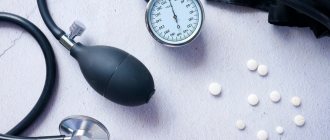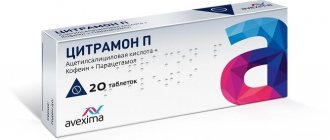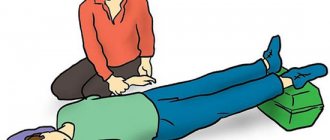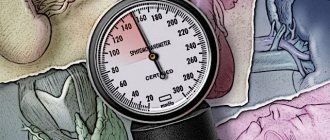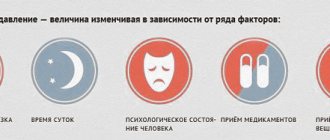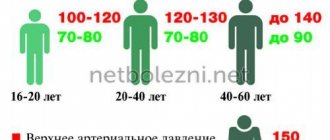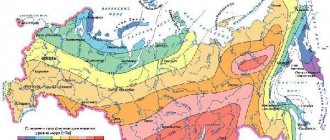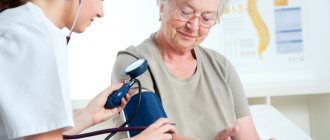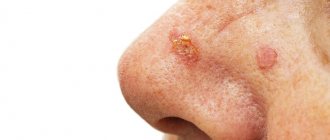Blood pressure (BP) is considered the most unstable indicator of the human body. Its level can change a huge number of times throughout the day at any age. This is due to hormonal levels, changes in weather conditions, emotional state, physical activity, etc. The average blood pressure is considered to be 120/80 mm Hg. Art. The numbers increase and decrease, the reasons for which may be physiological and pathological factors.
In this article we will talk about pressure readings of 100 to 60. What does this mean, should adults, children and women be wary of such numbers during pregnancy, and also what to do if the reasons for the appearance of such numbers on the tonometer are pathological processes in the human body.
What does each number mean?
Blood pressure is a measure of the pressure that blood exerts on the walls of blood vessels as it passes through them. The blood flow is created by the heart, which works like a pump. The heart muscle has the ability to contract (systole) and relax (diastole). During the first period, blood is pushed into large arteries, which is accompanied by the highest pressure levels. This is the first number. In this case we are talking about 100. The indicator is called systolic or upper (in common parlance) pressure.
During relaxation, the second number is recorded (in this case, 60). It is also called diastolic pressure or lower. Experts pay attention not only to these numbers, but also calculate the difference between them, calling this indicator pulse pressure. The blood pressure level is formed under the influence of the following factors:
- The force with which the heart pushes blood into the vessels.
- Hormonal background.
- Conditions of the central and peripheral nervous system.
- Conditions and indicators of arterial elasticity.
- The total volume of blood circulating in the body.
Important! The normal blood pressure level is considered to be 120–129/80–84 mmHg. Art.
Blood pressure 105 over 65 in the elderly
Unlike high blood pressure, blood pressure of 105/65 is not considered normal for an elderly person. As a rule, even those people who suffered from hypotension in youth and adulthood notice an increase in tonometer readings with age. There are a number of reasons leading to a pressure of 105 over 65 in an elderly person, physiological and pathological.
Physiological reasons include :
- Chronic hypotension. Low blood pressure from an early age, which accompanies an older person throughout his life.
- Orthostatic hypotension. A sharp decrease in pressure resulting from a sudden change in body position.
List of pathological causes :
- Drugs. Some medications have a lowering of blood pressure as a side effect.
- Recumbent lifestyle. Staying in bed for too long (for example, due to illness) can lead to hypotension in old age.
- Blood loss. Blood loss (for example, due to internal bleeding or surgery) has a huge impact on blood pressure.
In any case, if an elderly person is found to have low blood pressure, in particular 105 over 65, you should immediately contact a specialist.
Causes of hypotension
Biophysical factors that are involved in the development of hypotension are:
- Decreasing the amount of venous blood that returns to the heart.
- Decrease in total circulating blood volume.
- Reduced vascular resistance in the periphery.
- Decrease in cardiac output and stroke.
Pathologies of pregnant women
Blood pressure of 100 over 60 during pregnancy, especially in women over 30 years of age, is considered a pathology, especially if symptoms of hypotension are added. Most often, low blood pressure is observed at the end of the first trimester of pregnancy and at 19-23 weeks. Persistent hypotension can cause oxygen starvation of the fetus, which provokes the development of malnutrition and damage to the child’s central nervous system. It is important to monitor the blood pressure of a pregnant woman in order to have time to adjust the numbers.
Teenage years
Adolescents aged 12–13 years experience hormonal changes in the body, which may be accompanied by a decrease in blood pressure. Girls are more likely to face this problem than boys. Hypotension is combined with both accelerated physical development of the body and its slowdown.
Important! A persistent drop in blood pressure during puberty (adolescence) can trigger the development of severe hypertension at a later age.
Psychological characteristics and constitution
Experts say that low blood pressure (for example, 101 to 63, 104 to 64) is more often complained of by patients who are prone to depression and an exaggerated sense of duty. In such cases, treatment is largely aimed not at taking medications, but at using meditative techniques, yoga, breathing exercises, and herbal medicine.
If we talk about the relationship between arterial hypotension and body constitution, then people with an asthenic body type more often complain about a decrease in blood pressure. In such patients, longitudinal dimensions prevail over transverse ones: arms and legs are long, the neck is thin and long, and the muscles are poorly developed.
Lack of physical activity
Modern innovations in technology are causing people to stop moving. Most people prefer to work and relax while sitting at the computer. In this case, not only hypotension occurs, but also cardiovascular diseases, digestive pathologies, and diseases of the musculoskeletal system due to weakness of the muscular system and joints.
Chronic infections
A third of patients who go to doctors with complaints of low blood pressure, dizziness, periodic pulsation in the back of the head and frequent headaches have foci of chronic infection in the body. In this case, hypotension is caused by intoxication, metabolic disorders (metabolism), and circulatory disorders.
Endocrine diseases
The organs of the endocrine apparatus are responsible for the state of the body's hormonal levels. The most common causes of hypotension are Addison's disease (adrenal dysfunction, characterized by a decrease in the amount of hormones produced) and hypothyroidism (lack of thyroid hormones).
Medicines
Long-term or uncontrolled use of medications can serve as a factor in lowering blood pressure. We are talking about the following groups of drugs:
- Sleeping pills.
- Painkillers.
- Antibacterial agents.
- Tranquilizers.
- Sedatives.
- Diuretics, etc.
Is blood pressure 105 over 65 dangerous?
Before judging whether a blood pressure of 105/65 is dangerous, it is necessary to identify the type of phenomenon:
- Primary hypotension is typical for weather-dependent people, as well as people who lead a sedentary lifestyle, are exposed to constant stress and are regularly in nervous tension. Primary hypotension is characterized by normal human performance and activity in the first half of the day and a rapid reduction in vitality in the second half. This type of pressure 105 to 65 is uncritical and harmless. It only negatively affects your overall well-being.
- Secondary – a concomitant symptom of blood loss, chronic infectious and other diseases. Characteristic of immobility, malnutrition and lack of vitamins. In this case, the danger is not the pressure indicator itself, but the cause of hypotension that requires treatment.
- Normal for humans. This type is possible, and, moreover, very common, especially among teenagers and young women. In this case, a pressure of 105 over 65 does not require treatment, especially in conditions where the person has no complaints related to concomitant symptoms.
- Temporary phenomenon. Blood pressure is influenced by many factors, so its short-term and isolated decrease is not a reason for concern, for example, if a person has been in the sun for too long, his blood pressure is guaranteed to drop. The main thing is to ensure that the pressure of 105/65 does not become stable.
Thus, a pressure of 105 to 65 in itself is not dangerous and does not directly harm a person. Often, it only brings discomfort in the form of weakness, fatigue, etc. But hypotension can be a signal that something is wrong in the body, especially if the accompanying symptoms listed above are present.
Types of hypotonic conditions
Primary hypotension is characterized by a decrease in blood pressure, the causes of which are not pathologies of the heart and blood vessels. Secondary, on the contrary, is a manifestation of a disease. Depending on how long the numbers remain at low levels, acute and chronic forms of the pathological condition are distinguished. In the first case, if we talk about blood pressure 100/60, such numbers remain at a low level for a short time, in the second - over a long period.
Physiological form
We can talk about a physiological variant of hypotension if a pressure of 100/60 (or other low numbers) is discovered by chance, is not accompanied by a deterioration in general well-being and is caused by some physiological reason. Hypotension can be an individual variant of the norm, observed in people actively involved in sports and those living in tropical and subtropical climates.
Pathological form
This type of blood pressure reduction exists in two variations: neurocirculatory and idiopathic orthostatic. The first type manifests itself with a clear clinical picture, the second is characterized by a drop in blood pressure only if the body position changes from horizontal to vertical (for example, when getting out of bed in the morning).
Symptomatic form
She is secondary. It is a symptom of a certain disease. May occur against the background of:
Blood pressure 100 to 80
- Diseases of the heart and blood vessels (heart failure, cardiomyopathy, inflammation of the myocardium, pericardium).
- Pathologies of the respiratory system (pneumonia, tuberculosis, bronchial asthma).
- Diseases of the gastrointestinal tract (stomach and duodenal ulcers).
- Diseases of the renal apparatus (econephropathy, nephritis).
- Pathologies of the nervous system (Parkinson's disease, encephalopathy, cerebral infarction, mental illness).
First aid for an attack
In any case, a decrease in pressure, especially if for a particular person 105/65 is not the norm, brings discomfort. And there are a number of methods that are great for helping to raise blood pressure. The effect is short-term, but unconditional:
- Coffee. It is not for nothing that it is strictly prohibited for hypertensive patients, because caffeine is a substance that directly increases blood pressure. Strong black tea can also be a great alternative.
- Playing sports. Short-term but intense exercise is guaranteed to raise blood pressure, since physical activity directly affects the functioning of the heart and blood vessels responsible for blood pressure.
- Shower. A contrast shower quickly and effectively tones the entire body, affecting the circulatory system.
- Essential oils. Essential oils can help raise blood pressure temporarily. Citrus, pine and spicy aromas are excellent helpers, but it is better to avoid calming ones (for example, chamomile, mint, lavender).
- Food. Nuts, fruits and dried fruits, cheese and chocolate are an effective and tasty way to raise your blood pressure a little.
Feeling good with blood pressure 100/60
If the pressure drops sharply, the patient complains of headache, dizziness, pulsation in the back of the head, rapid heartbeat (at a pressure of 100 to 60, the pulse can reach 100 beats/min). Cold sweat, severe weakness appear, trembling in the limbs may occur, and body temperature decreases. The result of a critical drop in indicators is a fainting state requiring emergency assistance.
With chronic hypotension, the patient complains of daily weakness, fatigue, emotional lability, depression, and shortness of breath. With a chronic type of pathology, people get used to attributing their poor health to all sorts of factors, but not to a drop in pressure. The problem is associated with changes in weather conditions, fatigue at work, stress, overeating or, conversely, diet abuse.
Blood pressure 105 over 65 during pregnancy
Pregnant women regularly experience disturbances in vascular tone, which often leads to disruption of vascular function and, as a consequence, changes in constant blood pressure. This phenomenon occurs in approximately 12% of pregnant girls and women aged twenty to forty years.
But not for everyone this is a problem or a disease requiring treatment. Most pregnant women with a pressure of 105 over 65 feel well, are able to do work for a long time and efficiently and do not complain about anything. However, it is possible that the expectant mother feels sick and may have difficulty performing actions that previously did not require much effort.
Hypotension during pregnancy can be either a symptom of a more serious disease (infectious disease, allergic condition, renal failure, thyroid problems, etc.), or an independent disease.
In any case, the expectant mother is recommended to consult about blood pressure with her gynecologist leading the pregnancy, who can determine whether there is cause for concern.
Diagnostic measures
When contacting specialists with a problem of low blood pressure (for example, 100–106 to 60–66), patients are interested in the question of whether this is normal, and if not, how to improve the readings. The doctor must ask the patient about the following points:
- When were such pressure indicators first noticed?
- Associated symptoms.
- What is the patient’s “working” pressure?
- Do the patient and his relatives have any diseases of the cardiovascular system?
- The presence of pathologies of other systems.
- Does the person take any medications, etc.
Hypotension can cause fainting
Blood pressure must be measured several times at intervals of 5–10 minutes. If necessary, daily monitoring of blood pressure with monitoring of pulse and other indicators of heart function is prescribed. Additional methods include ECG, echocardiography, electro- and rheoencephalography, and examination by an ophthalmologist.
Causes
Pressure 105 over 65 has a lot of prerequisites of a different nature: both physiological (caused by improper functioning of internal organs and systems, unhealthy lifestyle, etc.) and psychosomatic (caused by stress, as a result of worrying, etc.). In addition, the reasons may vary depending on the gender of the person.
Among women
For women aged 20-40 years, a pressure of 105 over 65 is quite acceptable: among the fair sex, the pressure is almost always lower than among men. This is due to the fact that there are a number of differences in the functioning of the autonomic nervous system of men and women.
Blood pressure of 105/65 in women, as a rule, does not require any special treatment, especially if the person feels well and has no complaints.
In men
For men, especially those in good physical shape, a blood pressure of 105/65 is not typical. There are a number of reasons leading to low blood pressure in the stronger sex (sometimes these reasons are also relevant for women):
- lack of vitamins C, E, group B;
- exhaustion;
- stress, chronic fatigue, depression;
- weather dependence - weather changes and prolonged exposure to the sun;
- anemia;
- endocrine system disorders;
- vegetative-vascular dystonia;
- osteochondrosis of the cervical spine;
- infectious diseases;
- tuberculosis;
- stomach ulcer;
- hereditary predisposition;
- side effects of medications.
Correction of indicators and first aid
To increase the pressure, you must follow the following algorithm:
- Call a team of medical workers.
- Lie on a horizontal surface with the leg end raised or lay the victim down in this way.
- Open a window or direct a fan to provide fresh air.
- Drink sweet warm tea or give the victim something to drink. You can add 10 drops of tincture of eleutherococcus, ginseng or Rhodiola rosea.
- Rub your whiskey with lemon essential oil.
Treatment recommendations
First of all, it is necessary to normalize your lifestyle. You should do gymnastics daily, preferably in the fresh air. Evening walking, swimming, cycling, and light jogging are excellent options for low blood pressure. You should stop drinking alcohol and smoking and normalize your sleep. And it is also important to correct the diet: give up fried, smoked and fatty foods, include a large amount of vegetables and fruits, grains in the menu.
The prescription of medications depends on the type of hypotension. In the primary form of the pathology, anticholinergics are used, which have a sedative and antispasmodic effect. In order to increase the heart rate (according to indications) and increase the return of blood to the heart, sympathomimetics are prescribed.
And they also use preparations based on herbal and other natural ingredients (tincture of aralia, ginseng, zamanikha, camphor, Pantocrine, Saparal). In the treatment of symptomatic hypotension, attention should be paid to the treatment of the underlying disease that caused the decrease in blood pressure. To regulate blood pressure numbers, it is important to take vitamins:
- Thiamine.
- Riboflavin.
- Niacin.
- Pantothenic acid.
- Pyridoxine.
- Folic acid.
- Cyanocobalamin.
- Ascorbic acid.
- Calciferol.
Important! Hardening helps well, which can be used to prevent a hypotonic state.
Treatment
If a blood pressure of 105 over 65 is not normal for a given person, treatment is indicated (which should be prescribed by a specialist). There are four areas of therapy: drugs, nutrition, physical activity and, as an auxiliary method, traditional medicine.
Drug therapy
Caffeine is a time-tested substance that increases blood pressure. As a rule, therapists do not prescribe caffeine itself separately, but rather prescribe tablets (and other medicinal forms) that contain it, for example, Askofen, Citramon, etc.
However, not only caffeine helps with hypotension. Below is a list of drugs that are most often prescribed by specialists for a blood pressure of 105 over 65:
- Citramon. The drug not only increases blood pressure, but also has anti-inflammatory, antipyretic and analgesic effects.
- Ortho Taurine. Reduces calcium overload, removes excess fluid from the body, has a calming effect on the nervous system, and relaxes blood vessels.
- Regulton. Prescribed in connection with hypotension with accompanying symptoms of fear, anxiety, insomnia, dizziness, mental overload.
- Saparal. The drug helps people with hypotension complicated by depression and neurasthenia. It is also used as a prophylactic for mental and physical fatigue.
- Glycine. The drug is a neurotransmitter that improves metabolic processes in brain tissue, which leads to stabilization of the nervous system. As a result, the patient’s sleep normalizes, symptoms of depression are relieved, and irritability decreases. Prescribed to patients with psychosomatic causes of hypotension.
Nutrition
Nutrition is an important aspect of human life that significantly affects blood pressure. For example, a lack of vitamins B, C and E is often the cause of a blood pressure of 105 over 65. Therefore, your daily diet must be composed in such a way that foods containing vitamins are included in it.
The following food groups are rich in B vitamins:
- yeast (brewer's and baker's) and bran (rice and wheat);
- whole grains and wheat germ;
- cabbage and spinach;
- offal (kidneys, liver), egg yolk, chicken meat;
- tuna, salmon, sardine;
- peanuts, walnuts;
- broccoli, lentils.
Iron is also a very necessary trace element for the treatment and prevention of hypotension. A lot of iron is found in:
- dried fruits;
- beets, carrots;
- calf liver;
- beans, greens.
Strong blood vessels require essential oils, which are found in abundance in citrus fruits.
Salt is one of the food additives that naturally increases blood pressure. However, you shouldn’t overuse it either: a piece of cheese for breakfast and moderately salted food throughout the day can maintain the salt content in the body at an optimal level.
A cup of coffee in the morning and tea throughout the day can keep the body and blood vessels in good shape.
But everything is good in moderation. If a person’s blood pressure is 105/65, this does not mean that he needs to drink liters of coffee every day, or that his diet should consist only of the listed products.
And, of course, water. People with hypotension should drink more than the reference 1.5-2 liters of water per day.
The following video describes products that can increase blood pressure:
Physical activity
For people with a blood pressure of 105/65, long, exhausting “endurance” exercises are not recommended. On the contrary, short-term but intense exercise will be most welcome, for example, cardio exercise, speed running, etc.
However, when performing exercises, you should first of all listen to your own feelings: at the slightest signs of weakness, darkening in the eyes, dizziness, etc., physical activity should be stopped immediately.
Folk remedies
Medicinal herbs are indispensable assistants in traditional medicine for low blood pressure. Various tinctures, mixtures, drinks and herbal teas are an excellent auxiliary remedy, both in combination with drugs for secondary hypotension, and as a separate remedy for primary and temporary hypotension.
Extract of Eleutherococcus senticosus, tincture of common ginseng, Sterculia platanofolia, Leuzea safflower, Aralia Manchuriana are excellent in helping to normalize blood pressure, including hypotension. You can buy them at any pharmacy, and you need to take them before meals in the following concentrations in half a glass of water:
- Eleutherococcus senticosus extract – 2 milliliters;
- tincture of ordinary ginseng - from 20 to 40 drops;
- tincture of Sterculia planatafolia and Manchurian aralia - from 15 to 20 drops;
- Leuzea safflower extract – about 25 drops.
If a person does not tolerate infusions with alcohol, you can add the tincture to water and wait 20 minutes, after which the alcohol will evaporate and the tincture will not cause damage to the gastric mucosa.
Medicinal preparations are taken in courses of 2-4 weeks, after which a break of 1.5-2 weeks is required. In the future, if desired, the course can be repeated, but this time halved.
The first herbal recipe for hypotension:
- peppermint – 30 g;
- Manchurian aralia roots – 30 g;
- roots of Eleutherococcus senticosus – 25 g;
- Schisandra chinensis fruits – 15 g;
- May lily of the valley – 10 g.
Preparation. 1 tablespoon of herbal mixture is poured into a glass of boiled water and infused for 20 minutes.
Application. You need to consume a third of a glass twice a day, half an hour before meals.
Second recipe:
- Astragalus wooliflora – 20 g;
- Panax ginseng root – 20 g;
- hawthorn fruits – 20 g;
- chamomile flowers – 15 g;
- peppermint – 15 g;
- ephedra horsetail (upper part of the plant) – 10 g.
Preparation. 1 tablespoon of herbal mixture is poured into a glass of boiled water and infused for 20 minutes.
Application. The collection is taken three times a day - a third of a glass immediately after meals.
Third recipe:
- Schisandra chinensis fruits – 30 g;
- hawthorn fruits – 20 g;
- knotweed - 15 g;
- rhizomes of Leuzea safflower - 15 g;
- May lily of the valley – 10 g;
- chamomile flowers – 10 g.
Preparation. 1 tablespoon of herbal mixture is poured into a glass of boiled water and infused for 20 minutes.
Application. Twice a day, a third of a glass half an hour before meals.
Vitamin drinks are not inferior to tinctures and herbal preparations in terms of effectiveness. They are prepared and used in the same way as herbal preparations.
First recipe for a vitamin drink:
- St. John's wort - 10 g;
- hawthorn fruits – 15 g;
- stinging nettle – 15 g;
- rose hips – 20 g;
- Rhodiola rosea root – 20 g;
- high zamanikha roots – 20 g.
Second recipe:
- Calendula officinalis flowers – 10 g;
- large plantain leaves – 10 g;
- red rowan fruits – 10 g;
- St. John's wort - 10 g;
- rhizomes of Leuzea safflower - 15 g;
- Manchurian aralia roots – 15 g;
- hawthorn fruits – 15 g.
Do not forget about the proven folk remedy - Chinese lemongrass . A variety of health drinks can be prepared from its fruits: syrup, juice, jelly, fruit juice and tea. The plant has a tonic effect, invaluable for blood pressure of 105 to 65.
Chinese lemongrass juice recipe:
- fresh berries are thoroughly washed under running water;
- after this, juice is squeezed out of the berries (manually or using a juicer);
- the resulting juice is poured into sterilized half-liter jars;
- jars with juice are re-sterilized for 10-15 minutes and sealed.
This juice is added to tea, 1 teaspoon per glass and consumed twice a day. In addition, it can be used instead of citric acid.
Chinese lemongrass syrup recipe:
- granulated sugar is added to the resulting Chinese lemongrass juice (according to the method above) in the ratio of 1 liter of juice per 2 kilograms of granulated sugar;
- the dishes with the mixture are placed on low heat until the sand is completely dissolved;
- the resulting syrup is poured into sterilized dark glass jars.
The syrup, like juice, can be added to other drinks, and can be stored for up to three years in a cool, dark place.
